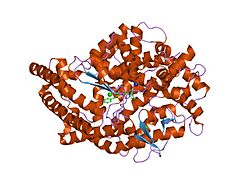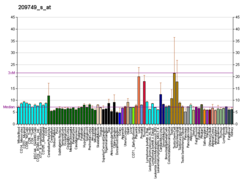
Back إنزيم محول للأنجيوتنسين Arabic لونزيم لبدالة للونجيوطونسين ARY Enzim conversiu de l'angiotensina Catalan Angiotenzin konvertující enzym Czech ACE Welsh Angiotensin-konvertierendes Enzym German Enzima convertidora de angiotensina Spanish Angiotensiini konverteeriv ensüüm Estonian Angiotentsinaren entzima bihurtzaile Basque آنزیم مبدل آنژیوتانسین Persian
 Angiotensin-converting enzyme monomer, Drosophila melanogaster | |||||||||
| Identifiers | |||||||||
|---|---|---|---|---|---|---|---|---|---|
| EC no. | 3.4.15.1 | ||||||||
| CAS no. | 9015-82-1 | ||||||||
| Databases | |||||||||
| IntEnz | IntEnz view | ||||||||
| BRENDA | BRENDA entry | ||||||||
| ExPASy | NiceZyme view | ||||||||
| KEGG | KEGG entry | ||||||||
| MetaCyc | metabolic pathway | ||||||||
| PRIAM | profile | ||||||||
| PDB structures | RCSB PDB PDBe PDBsum | ||||||||
| |||||||||
Angiotensin-converting enzyme (EC 3.4.15.1), or ACE, is a central component of the renin–angiotensin system (RAS), which controls blood pressure by regulating the volume of fluids in the body. It converts the hormone angiotensin I to the active vasoconstrictor angiotensin II. Therefore, ACE indirectly increases blood pressure by causing blood vessels to constrict. ACE inhibitors are widely used as pharmaceutical drugs for treatment of cardiovascular diseases.[5]
Other lesser known functions of ACE are degradation of bradykinin,[6] substance P[7] and amyloid beta-protein.[8]
- ^ a b c GRCh38: Ensembl release 89: ENSG00000159640 – Ensembl, May 2017
- ^ a b c GRCm38: Ensembl release 89: ENSMUSG00000020681 – Ensembl, May 2017
- ^ "Human PubMed Reference:". National Center for Biotechnology Information, U.S. National Library of Medicine.
- ^ "Mouse PubMed Reference:". National Center for Biotechnology Information, U.S. National Library of Medicine.
- ^ Kaplan's Essentials of Cardiac Anesthesia. Elsevier. 2018. doi:10.1016/c2012-0-06151-0. ISBN 978-0-323-49798-5.
Mechanisms of Action:ACE inhibitors act by inhibiting one of several proteases responsible for cleaving the decapeptide Ang I to form the octapeptide Ang II. Because ACE is also the enzyme that degrades bradykinin, ACE inhibitors increase circulating and tissue levels of bradykinin (Fig. 8.4).
- ^ Fillardi PP (2015). ACEi and ARBS in Hypertension and Heart Failure. Vol. 5. Switzerland: Springer International Publishing. pp. 10–13. ISBN 978-3-319-09787-9.
- ^ Dicpinigaitis PV (January 2006). "Angiotensin-converting enzyme inhibitor-induced cough: ACCP evidence-based clinical practice guidelines". Chest. 129 (1 Suppl): 169S – 173S. doi:10.1378/chest.129.1_suppl.169S. PMID 16428706.
- ^ Hemming ML, Selkoe DJ (November 2005). "Amyloid beta-protein is degraded by cellular angiotensin-converting enzyme (ACE) and elevated by an ACE inhibitor". The Journal of Biological Chemistry. 280 (45): 37644–37650. doi:10.1074/jbc.M508460200. PMC 2409196. PMID 16154999.





